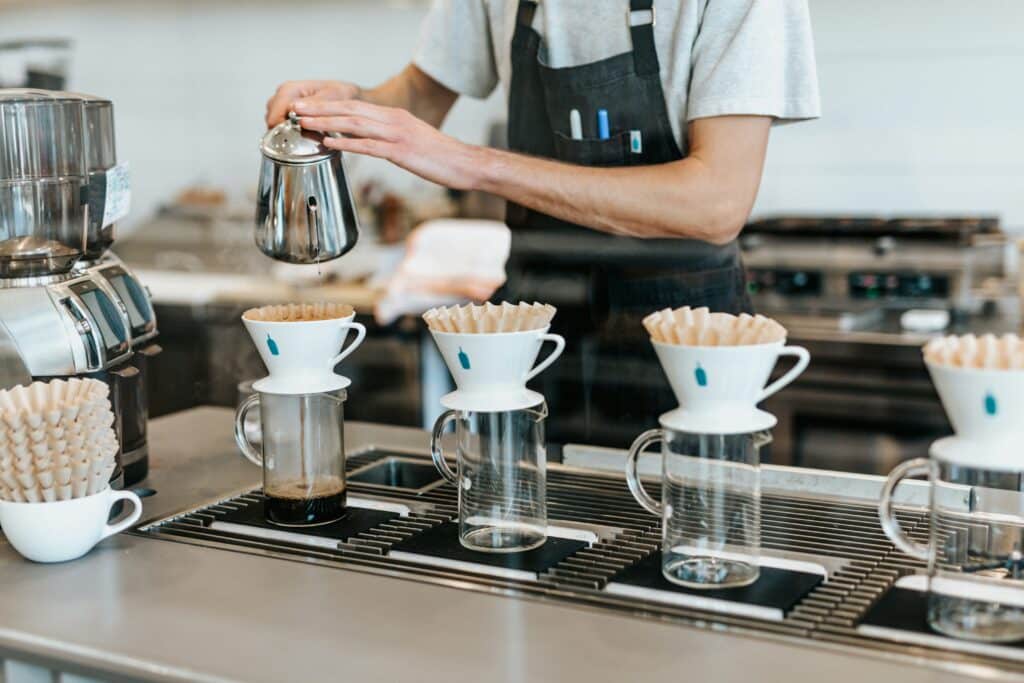By visiting our site, you agree to our privacy policy regarding cookies, tracking statistics, etc.
Running a coffee shop involves blending the art of crafting the perfect brew with the science of efficient management.
This article focuses on the many recurring tasks for successful operations of a coffee shop. To learn more about how to open a coffee shop, read our previous article.
From the moment the doors open to closing time, there are many parts that play a critical role in running a successful coffee shop. This article delves into many of these areas, from the nuances of daily operations, to effective hiring and training of staff, and the numerous managerial tasks in-between that ensure smooth operations.
As we explore labor management, accounting, and the integration of restaurant software, we’ll share valuable insights on how to run your coffee shop efficiently and set the stage for long-term growth. By focusing on these key areas, owners and management can not only enhance the operational efficiency of their establishments but also create a welcoming space that resonates with customers.
Running a coffee shop efficiently demands a robust approach to store operations. From the meticulous opening and closing procedures to the consistent delivery of exceptional customer service, this section encompasses the day-to-day tasks that form the backbone of your coffee shop’s success.
The successful operation of a coffee shop requires efficient opening and closing procedures. This includes the daily ritual of cleaning and maintenance to create a welcoming environment for customers and any ingredient prep that needs to take place for the following day. By instilling a culture of attention to detail in these procedures, coffee shop owners can establish a smooth and reliable daily routine.
The first step for managers is to set up a daily opening checklist and closing checklist for employees to follow. Remember that, in addition to daily checklists, you’ll also want to develop weekly and monthly checklists for maintaining equipment, inventory management, and other recurring tasks at your shop.
It’s important to create a daily checklist for managers as well. While employees typically handle daily cleaning of the shop and inventory prep, managers have a number of daily back-office tasks like monitoring daily sales and reviewing metrics like cost of goods sold (CoGS). Many operators monitor these key performance indicators through restaurant management software, which significantly reduces the time required to do so.

Exceptional customer service is a crucial component of any successful coffee shop. Training staff on effective customer interaction and implementing a service-oriented culture ensures that customers not only enjoy a great cup of coffee but also a memorable overall experience. By prioritizing customer satisfaction, coffee shop owners can build a loyal customer base and enhance the overall reputation of their establishment.
Consider these key areas to ensure your team is equipped to provide an exceptional customer experience to your customers:
Continuous Training and Feedback: Customer service trends and preferences evolve, so make training an ongoing process. Regularly update your staff on new products, techniques, and customer service strategies. Encourage open communication and provide constructive feedback to help them continuously improve.
Handling customer complaints and feedback is also a crucial part of customer service training. When faced with a dissatisfied customer, it’s essential to approach the situation with empathy and a solution-oriented mindset. Actively listen to their concerns, allowing them to express their dissatisfaction fully. Remember, every complaint is an opportunity to improve. Once the customer has voiced their grievances, apologize sincerely and assure them that their feedback is valued. Consider offering a tangible solution, such as a complimentary beverage or a discount on their next visit.
Transparency is also key. If there’s a delay or an issue, communicate it openly. Additionally, proactively seek feedback from all customers, not just those with complaints. Constructive criticism can unveil areas for improvement and highlight what’s working well. Whether it’s through comment cards, online surveys, or a dedicated email address, create channels for feedback, both positive and negative, from your customers.
Regular menu reviews and updates are essential to keep offerings in line with current trends, customer preferences, and ingredient availability. This process involves analyzing sales data, seeking customer feedback, and adapting the menu to cater to evolving tastes.
Seasonal offerings and promotions add a dynamic element to the menu, providing customers with new and exciting choices that reflect the changing seasons or special occasions. These limited-time options not only keep the menu fresh but also create a sense of anticipation among patrons.
Menu engineering – a strategy that’s become more common amongst today’s restaurant and coffee shop operators – involves strategically placing items on the menu to maximize sales and profitability. By identifying high-margin items and promoting them effectively, coffee shop owners can optimize their menu for both customer satisfaction and financial success.
In essence, effective coffee shop menu management is a delicate balance of tradition and innovation, ensuring a delightful and profitable experience for both the business and its patrons.
See why more than 40,000 restaurants use Restaurant365
The success of a coffee shop is intricately tied to the efficiency of its inventory management. This starts by establishing strong relationships with reliable suppliers, which helps keep CoGs as low as possible.
Maintaining control over inventory levels and optimizing the ordering process helps prevent stockouts or excess stock, contributing to cost efficiency and overall operational smoothness. Continuous improvement in inventory processes ensures that the coffee shop can adapt to changing market conditions and consistently deliver a delightful customer experience.
As a manager, be sure to institute a system for tracking inventory effectively. Your high cost and high use items should be counted daily, while other ingredients might be tracked weekly. Whatever process and frequency you use, make sure to train any staff that’s performing counts to prevent inventory loss or spoilage.
Restaurant management software plays a pivotal role in enhancing inventory management for coffee shops. These tools facilitate the integration between the shop and its vendors, streamlining their operations. Through real-time data insights, owners can monitor inventory levels, track consumption patterns, and anticipate supply needs. Integration between the software and vendors allows for automated ordering processes, reducing the likelihood of human errors and ensuring timely replenishment of essential items. This not only minimizes the risk of stockouts but also helps control vendor costs by optimizing order quantities.
By leveraging technology to enhance communication and collaboration with suppliers and streamline inventory management, coffee shops can achieve greater precision and reduce CoGS. This in turn leads to a more resilient business model and greater profit margins.
A restaurant business is only as good as its employees, so it’s important to find a skilled and motivated team. Labor costs have risen significantly across the restaurant industry since the COVID pandemic, so managing your workforce requires extra attention, from hiring, to training and employee recognition.
Your recruitment and hiring processes need to be strategic, focusing on finding individuals who not only possess the necessary skills but also align with your values and the atmosphere you’re trying to create for customers. Be thoughtful and transparent in any job descriptions you post to find employees. Remember that a robust hiring process will lead to less employee turnover, which in turn reduces labor costs.
Once onboard, comprehensive training programs ensure that employees are equipped to deliver top-notch service. As a manager, train your employees not just in drink prep and other standards, but any intricacies or differences between your coffee shop and your competitors that you feel make you stand out.
Nurturing a positive work environment is a goal for any manager. This involves consistently evaluating and recognizing employee performance. Regular performance evaluations provide constructive feedback, helping employees understand their strengths and areas for improvement. For your top performers, institute recognition and incentives to reward their commitment. Consider implementing a barista of the month program and use social media to shout out your best employees, and provide them with perks and cross-training opportunities.

A well-structured and efficient schedule reduces many of the headaches for both managers and their employees. Beyond the mere task of coordinating shifts, it prevents staff shortages that can significantly impact the service provided to customers in need of their daily caffeine. Here are some strategies to keep in mind when developing your scheduling system.
Compliance with labor laws and regulations is a non-negotiable aspect of labor management. This includes ensuring staff adherence to health and safety regulations, proper training on compliance matters, and staying updated on any legal changes that may impact the workforce. By prioritizing compliance, coffee shop owners can mitigate risks and create a secure environment for both employees and customers.
While a manager doesn’t need to be an accounting buff, a solid understanding of the many financial aspects of your coffee shop is imperative for sustaining a thriving business. This section emphasizes the importance of regular financial reporting, budgeting, and forecasting to maintain financial health. By maintaining a vigilant eye on the financial aspects, coffee shop owners can make informed decisions to optimize their business operations.
Regular financial reporting is a crucial component of running any restaurant business. Management and owners need to review financial statements consistently to gain insights into the business’s financial health.
The restaurant profit and loss (P&L) statement, often referred to as the income statement, is a financial document that provides a snapshot of a restaurant’s financial performance over a specific period. This comprehensive statement is a critical tool for owners, managers, and stakeholders to assess the profitability and operational efficiency of the establishment.
While in the past, many restaurant businesses operated on quarterly and monthly P&L statement review, restaurant software has facilitated this process. Many industry leaders now review P&Ls weekly, or even daily, to have better oversight into their costs and address problems more quickly.
Another specific metric that should be at the top of any operator’s list is actual vs. theoretical (AvT) food cost. AvT is a crucial metric, representing the comparison between the cost of ingredients used in food and beverages and the expected cost based on recipes and ingredients. The theoretical food cost is the calculated cost of each item offering if prepared precisely according to the recipe and portion guidelines. On the other hand, the actual food cost reflects the real cost incurred during the production of menu items, considering variations in ingredient prices, waste, and portioning discrepancies.
Monitoring and analyzing the variance between actual and theoretical food costs is vital for coffee shop owners and managers to identify areas of improvement in cost control. If the actual food cost exceeds the theoretical cost, it may indicate issues such as over-pouring, improper portion control, or inefficient purchasing practices. Regularly updating recipe costs and conducting frequent inventory checks can help maintain accuracy in theoretical food cost calculations.
It’s important to remember that identifying areas of inefficiency for cost reduction isn’t something that can be set and forget. It must be an ongoing process and a moving target to maintain operational efficiency at your coffee shop.
Coffee shops, like all of today’s restaurant businesses, have access to more and more of their data every day through software. While AvT gives a long-term view into your efficiency, here are a few additional key reports that are available in restaurant software that help monitor the health of your coffee shop and your staff’s performance:

In an era where technology plays a pivotal role in business operations, restaurant software is a key consideration for coffee shop management. The integration of POS with other essential systems, such as store accounting software, creates a synchronized ecosystem. This seamless connectivity reduces manual data entry errors and enables real-time updates on stock levels, pricing, and sales.
For coffee shops, where maintaining optimal stock levels is crucial, inventory management software is also essential. This integration provides a comprehensive overview of the entire supply chain, uncovering areas for improvement. Real-time data insights allow coffee shop owners to monitor inventory levels, track burn rates, and anticipate supply needs. An automated ordering processes, facilitated by the integration of software with vendors, minimize the risk of human errors and ensure timely replenishment of essential items. This not only prevents stockouts but also contributes to controlling vendor costs by optimizing order quantities.
Software touches every part of running a successful coffee shop in the digital age. The connection between these software creates a synchronized ecosystem, empowering you and your team to make informed decisions based on accurate and up-to-date information.
The successful operation of a coffee shop from a restaurant management perspective requires a holistic approach that encompasses store operations, labor management, and financial reporting. Meticulous attention to opening and closing procedures, customer service excellence, and dynamic menu management set the foundation for a thriving coffee shop. Strategic staffing and effective performance management contribute to a positive work environment and employee retention. Sound financial practices, including regular financial reporting, are essential for financial sustainability.
From the intricacies of day-to-day operations to the integration of advanced restaurant software, operators can navigate the complexities of the industry, creating a thriving and sustainable business that resonates with customers and stands the test of time.
Share this blog:
Read More:
See why more than 40,000 restaurants use Restaurant365
500 Technology Drive, Suite 200
Irvine, CA 92618
Westech 360
8911 N Capital of Texas Hwy
Building 1, Suite 1200
Austin, TX 78759
Restaurant365 bridges the gap between accounting and operations by centralizing all data, helping restaurant operators to become more efficient, accurately forecast, and tackle any challenge or opportunity with speed and accuracy.